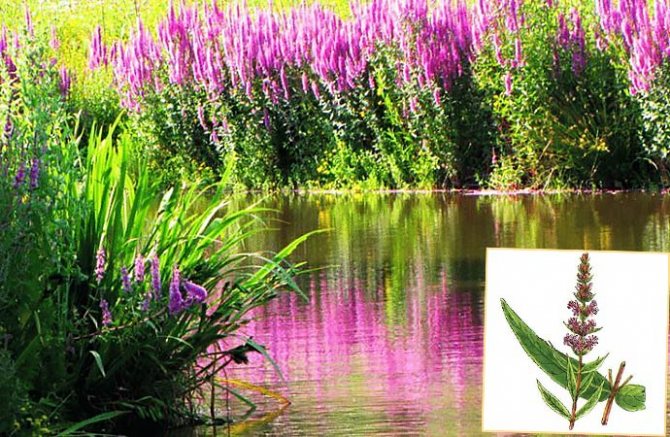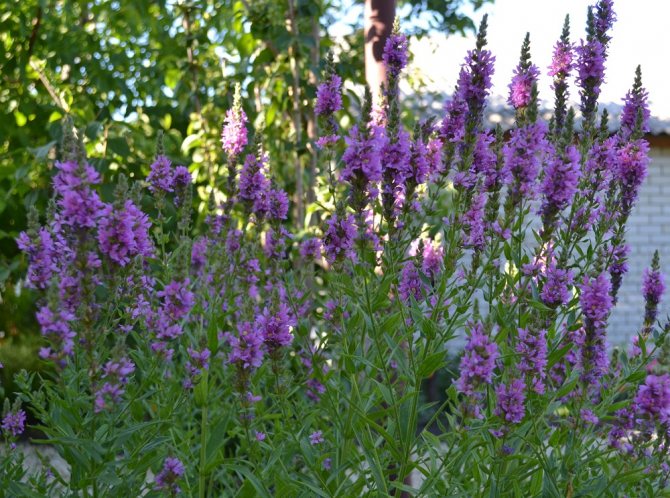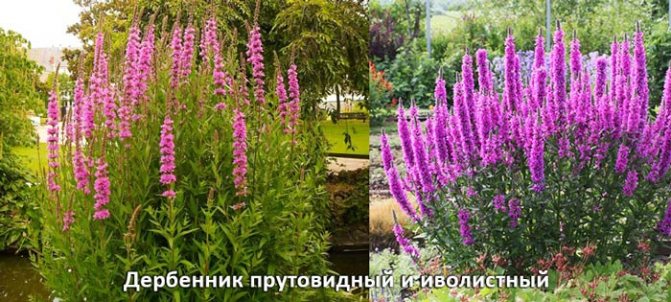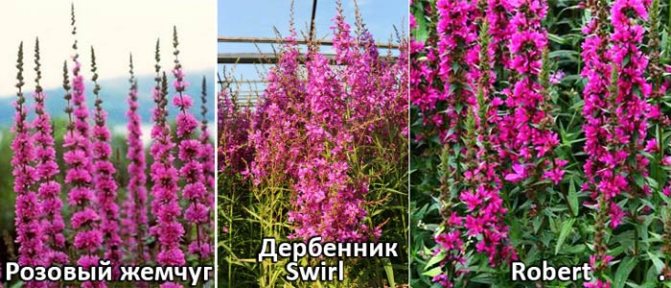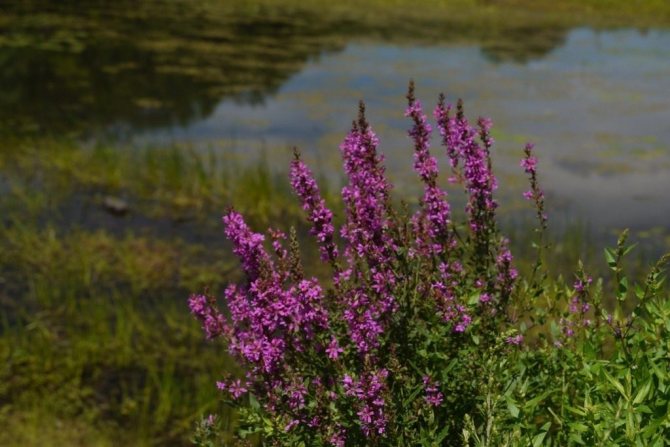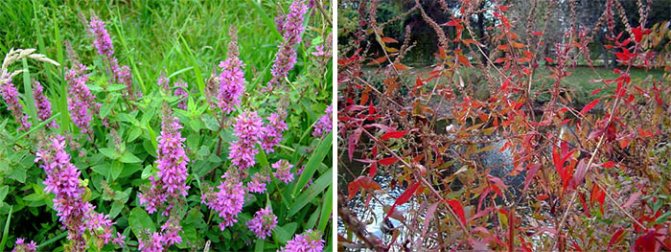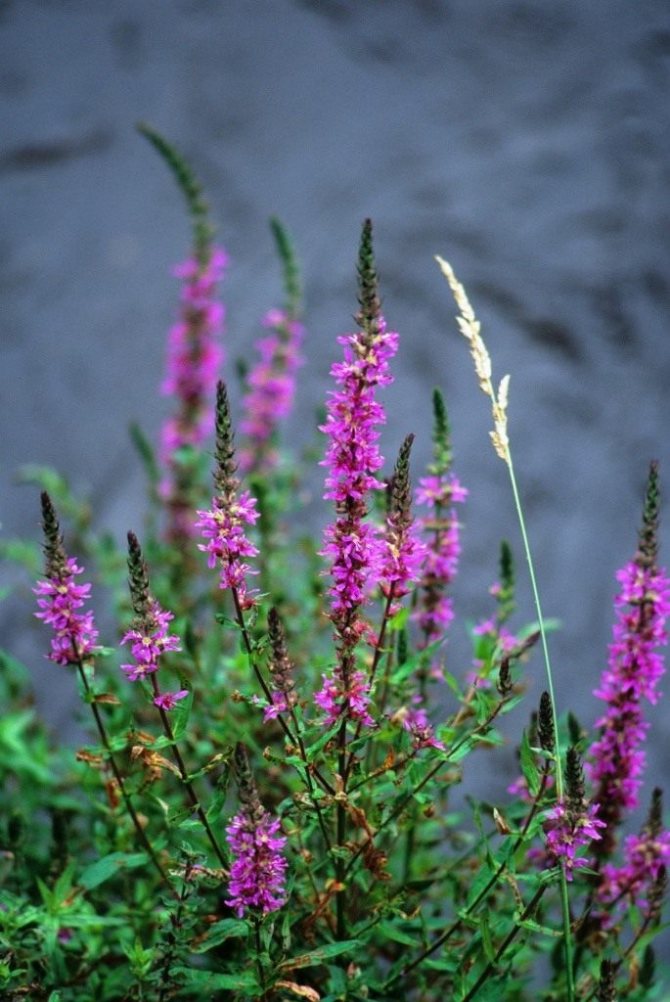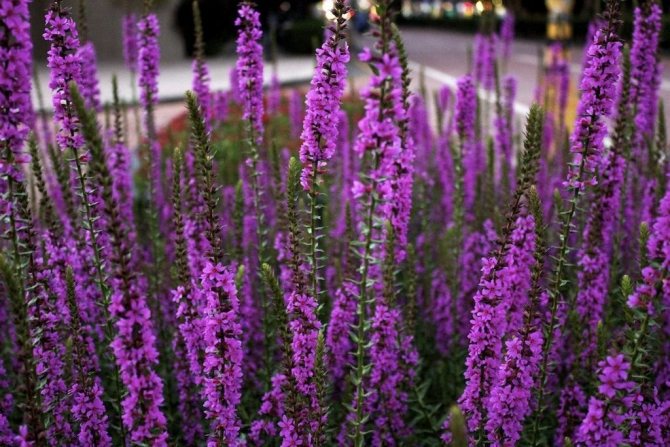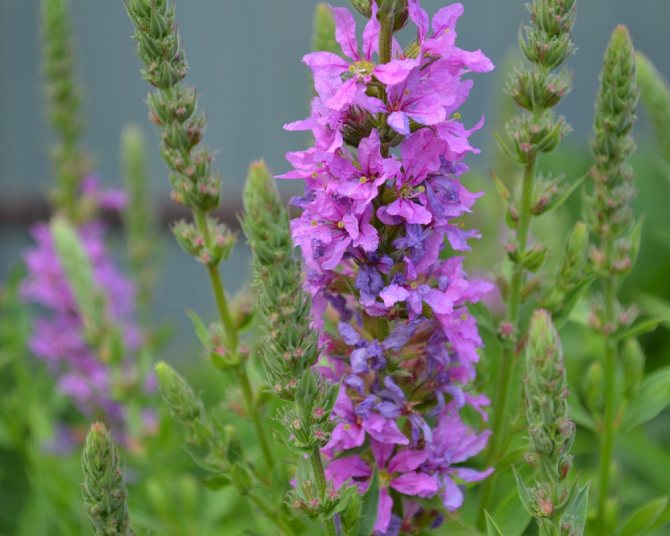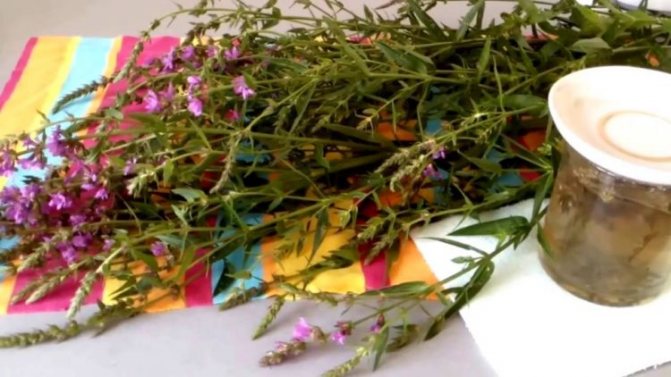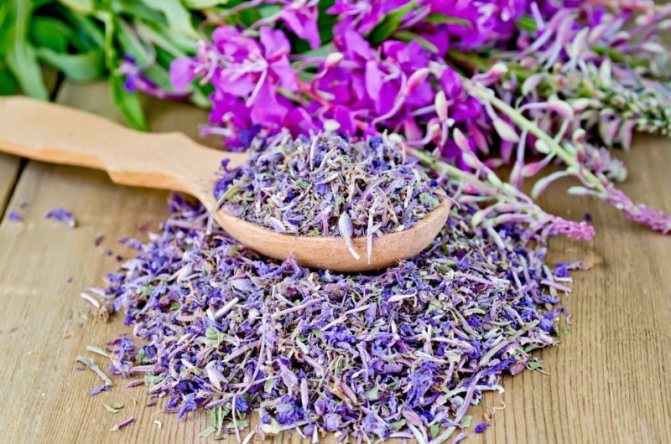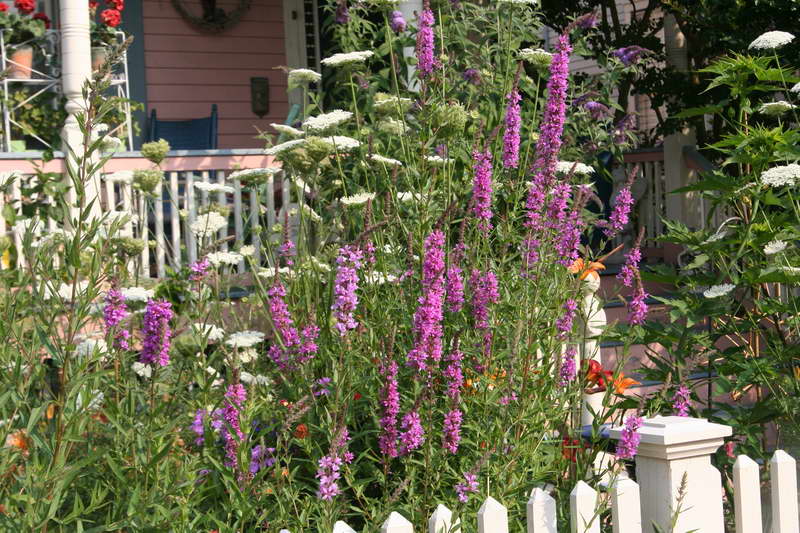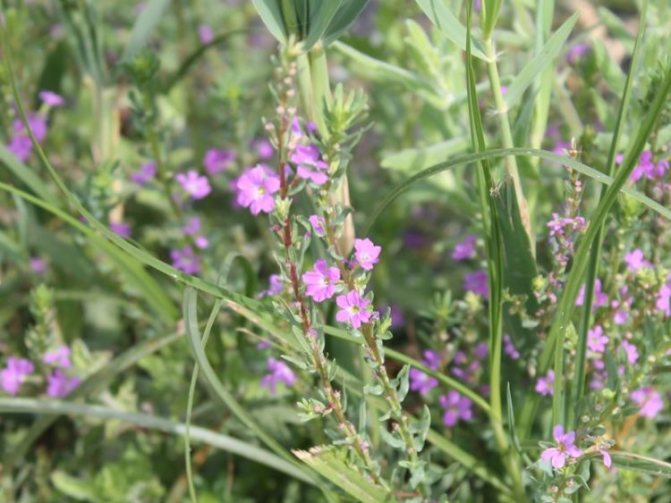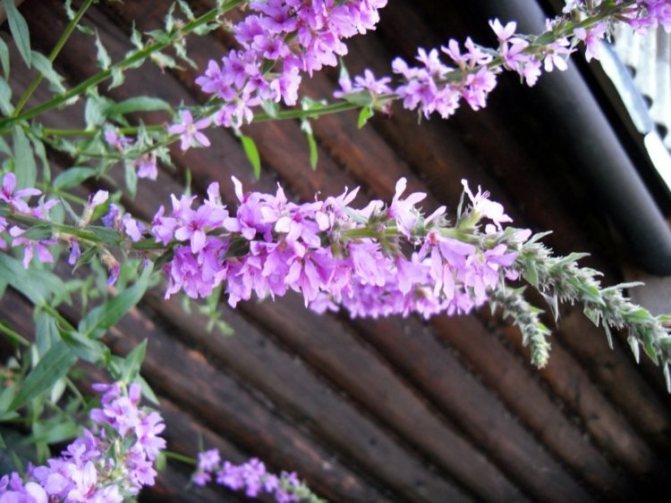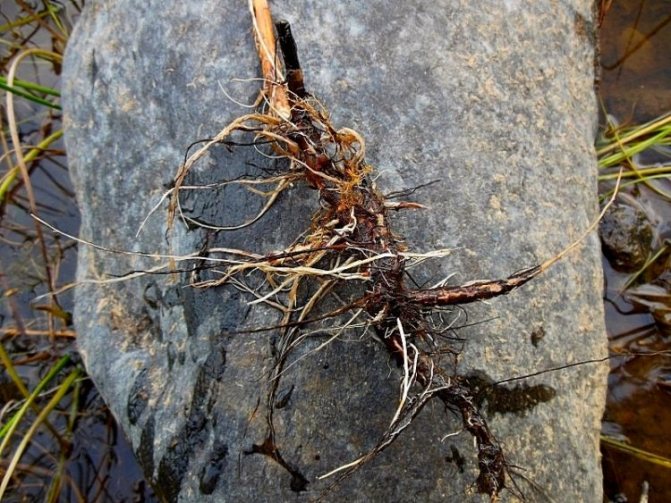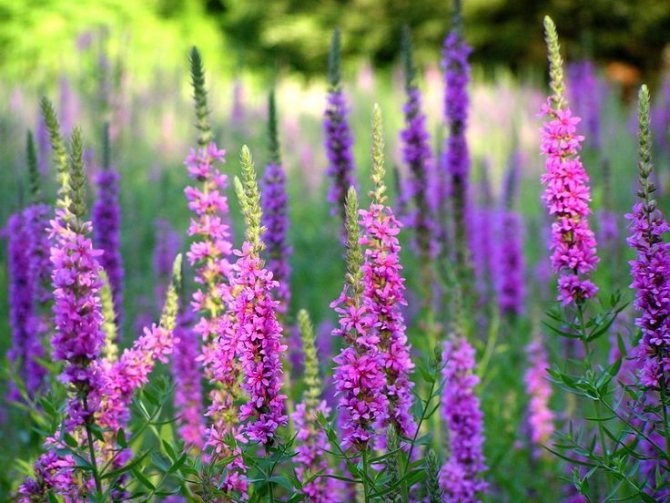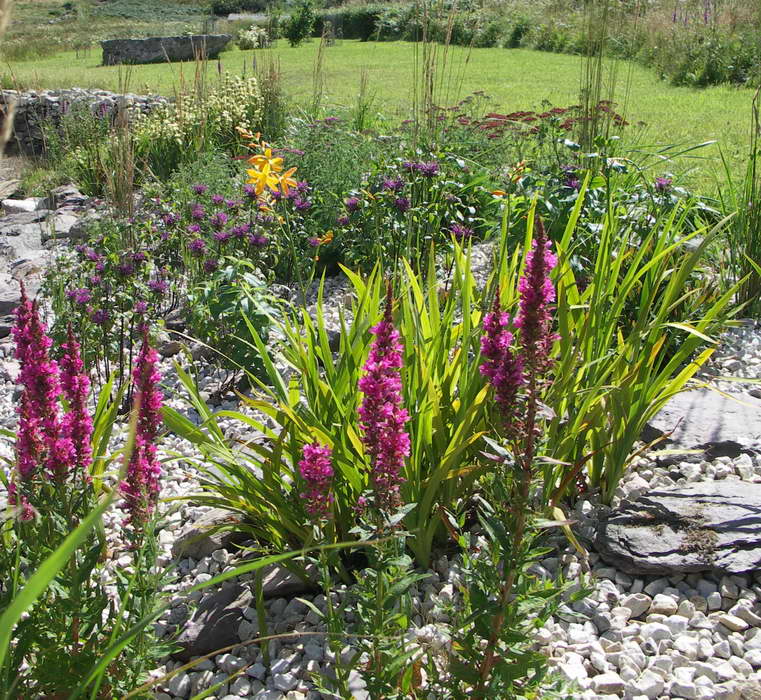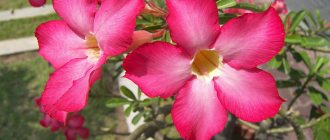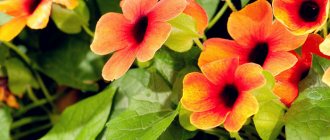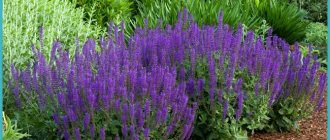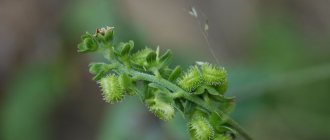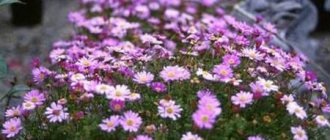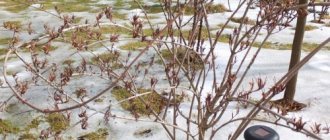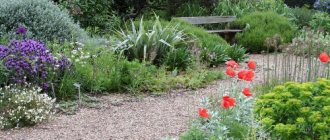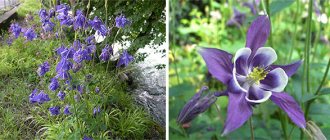On the banks of rivers or on the outskirts of swamps, you can see extensive clumps of tall plants with spike-shaped pink, purple or purple inflorescences. This is a loosestrife (lat.Lythrum), also popularly nicknamed the bobbery, is a perennial herb belonging to the family of loosestrife (lat.Lythroideae).
Another common name for loosestrife is plakun-grass. This is due to the fact that in the summer, in the morning, small drops of water can be seen on its leaves - this is how the plant gets rid of excess moisture. And according to legend, the transparent droplets are the tears of the Virgin Mary mourning her son.

[!] According to the botanical classification, the looser is the closest relative of the pomegranate.
It is believed that the original homeland of the loosestrife was Eurasia, but together with humans, it spread throughout almost the entire globe, except for the Arctic and Antarctic. The first thing that attracts attention in plakun-grass is its high (up to 50 cm) bright inflorescences, consisting of small star-shaped flowers of different shades. It is thanks to its exquisite appearance and amazing unpretentiousness that this perennial quickly won the love of gardeners.
In addition to its spectacular appearance, the loosestrife has other indisputable advantages:
- The plant is medicinal. Moreover, this fact is recognized by both traditional and official medicine. When preparing broths, all parts of the plant are used, both roots and stems with leaves. The loosestrife helps with dental problems, diseases of the genitourinary system, headaches, colds.
- The loosestrife is a melliferous plant, and the honey obtained from it has a tart and pleasant taste.
- From flowers and roots of plakun-grass, a yellow food coloring is produced, which is distinguished by high persistence.
- The tannins contained in the roots are used to impregnate fishing nets, which protects them from decay.
Description of the plant
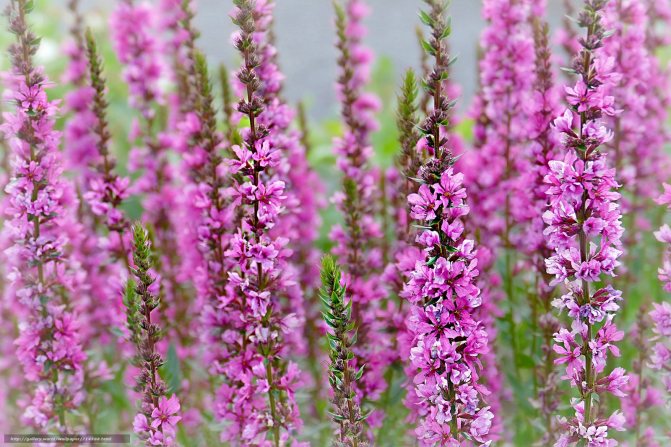

All representatives of the Derbennikov family are very similar in appearance. There are about 30 species, on the territory of Russia you can find no more than 10 species. Under favorable conditions, the grass grows into a wide bush. Prefers to germinate along river banks, on wet soils of marshy places, flooded meadows.
On a straight stem, dark, elongated leaves grow densely. With a characteristic description of loosestrife flowers, attention is paid to the star-shaped shape of small flowers of bright crimson and pink shades, located tightly on a paniculate spike-shaped inflorescence.
The root system is tree-like, creeping, superficial, shallow.
The flowering period of the loosestrife is June - September.
The most widespread are willow and rod-shaped loosestrife, which do not have any special decorative distinctive features.
The perennial flower loosestrife fits perfectly into various garden compositions. It is used as an ornamental plant for ponds and gardens. In its natural environment, the plant mainly grows along ponds and reservoirs. Prefers moist soils, but feels good even when the soil dries out.
The loosestrife has proven itself as a herb for outdoor use.
Plakun is of particular value - herbs are excellent melliferous qualities.Honey turns out to be yellow, with an amber hue, transparent, aromatic, with a pleasant tart taste.
External characteristics and habitat
The best place for upland reeds is a swampy plain. The Far East and Western Siberia are rich in loosestrife. The plant is also found in large quantities in the Ukraine, the Caucasus and the Republic of Belarus. The willow loaf prefers sandy soils, swamps and flood meadows.
In total, there are about 15 species of plakun-grass. The most famous representatives of the family of dicotyledonous plants are pink pearls, Lady Sackville, Blush, Robert Loose.
The willow variety has a well-developed root system. The bush grows in a bunch. At home, it can be propagated both by seeds and by division and cuttings. The height of the plant is no more than one and a half meters. Stems are dense, elastic
... Leaves are sessile, thin, staggered. On the back side there are stomata that remove excess moisture. It may seem that the plant is shedding tears. Thanks to this feature, the loosestrife is called plakun-grass.
The upland reed blooms from July to October. Inflorescences are located at the top of the stems. The bud has 6 petals in pink or purple tones. The plant is a honey plant. It attracts bees during flowering. The finished product has a tart taste and a unique aroma.
Types and varieties
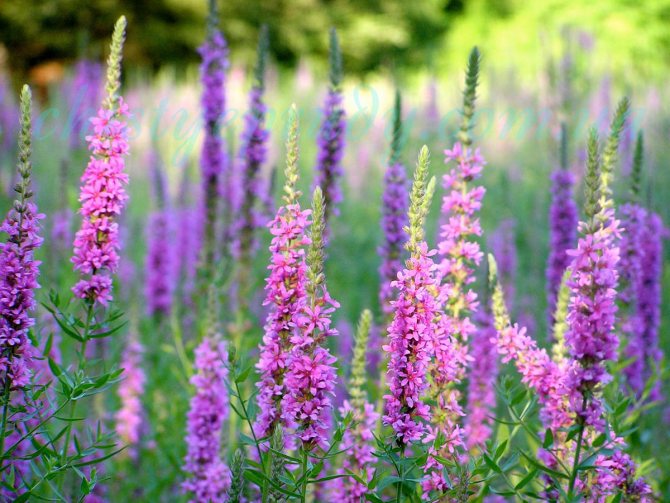

Willow loosestrife prefers wet meadows and fields in Europe and Asia. The height of the bush is 80 - 140 cm, the stem of the peduncle is straight, mostly vertical. Leaves are straight lanceolate, in the period of flowering green, and in the autumn - red. Flowers are stars, small, up to 1 cm in diameter, collected in dense spike-like inflorescences, with a red and purple tint.
Flowering period June-August. The seeds are small, formed after the flowering period and represent an elongated rounded box.
“Pink Pearl” is one of the brightest representatives of the common varieties of loosestrife. A distinctive feature of this perennial frost-resistant plant is dense erect paniculate and spike-shaped inflorescences of bright lilac-pink star-shaped flowers. The leaves are elongated, densely germinate from the rhizome. The species grows up to 100 - 120 cm. Under favorable conditions, it grows widely, forming large clumps. Feels comfortable sprouting in one place. In the cold period, it does not require special care. At the end of autumn, it is necessary to remove the entire aboveground part.


loosestrife "Pink pearl"
The variety of loosestrife “Robert” is a low compact bush up to 60 cm high. The flowers are bright red.
The Blanche loosestrife variety is distinguished by its high growth. The shade of flowers is soft pink. Compared to other species, the inflorescences are not as bright and saturated.
The “Lady Sackville” variety of loosestrife is a fairly tall plant, perfect for creating garden beds. Due to its high growth, it looks beautiful along the fences from the walls. Crimson flowers.
Prutovidny loosestrife is a very unpretentious light-loving plant. Feels quite comfortable even in dry ground. Flowering time July - August, grows up to 120 cm. The greatest distribution in the natural environment is observed in the temperate climatic zone of Europe and Asia. Compared with willow loafer, the colors of flowers are brighter, more saturated color, pink - crimson shades prevail. Inflorescences are not so densely arranged, the stem branches. Does not require special care in winter, it is enough to dig in with snow tightly to preserve the root system.
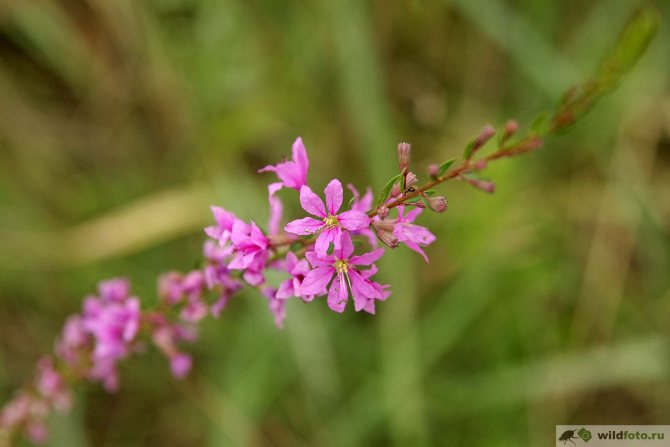

Loosestrife
Compared with willow loafer, the colors of flowers are brighter, more saturated color, pink - crimson shades prevail.Inflorescences are not so densely arranged, the stem branches. Does not require special care in winter, it is enough to dig in with snow tightly to preserve the root system.
The most famous varieties:
- The Rocket - bush height 60 - 80 cm, blooms with bright pink flowers;
- Dropmore Purple - bush height up to 1 m, flowers are pale purple-pink;
- Helene is a compact bush 50 cm high with a purplish pink tinge of flowers;
- Modern Gleam - bush height up to 90 cm, rich crimson flowers;
- Modern Pink - bush height up to 1 m, with fuchsia-pink flowers;
- Rose Queen is a small bush up to 70 cm in height, pink flowers with a purple tint.
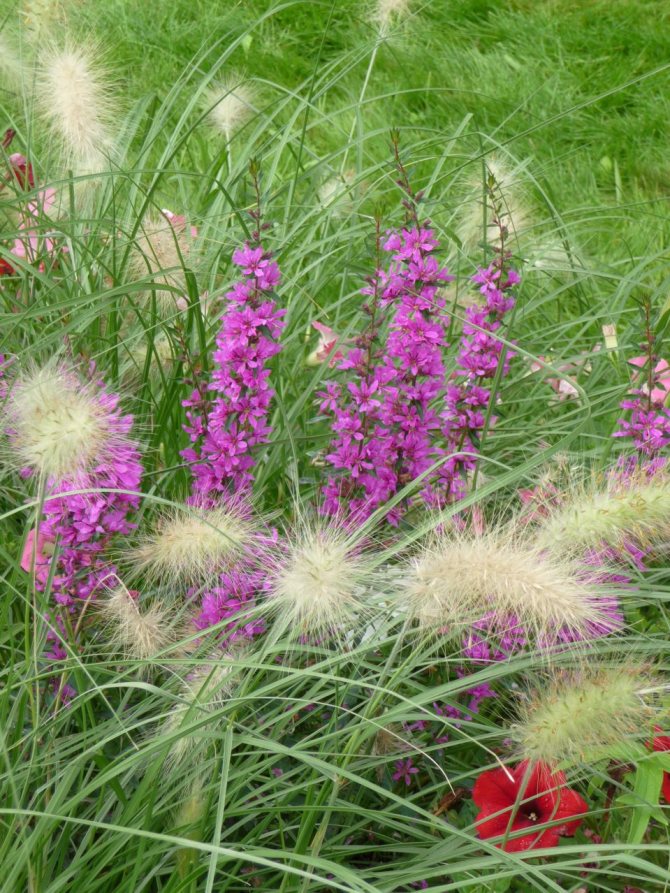

Loosestrife
Common loosestrife can be found in the steppes and in meadows along the banks of rivers, at the edges of forests. The plant population on the territory of Russia is greatly decreasing, and therefore, Derbennik is listed in the Red Book.
Further care for the loosestrife
Derbennik is very fond of fertile soil, grows well not only in partial shade, but also in sunny, blown areas.
For the very lazy and busy further care
is this: planted and forgotten. It grows in one place for many years, does not require winter shelter. You just have to restrict it in distribution, but cut off the aerial part for the winter.
For more inquisitive people, not looking for easy ways, people can be advised to loosen the soil, especially in the first year of planting a loosestrife in the ground, abundant watering in hot dry weather, fertilizing with fertilizers during the flowering period. The loosestrife blooms in June-July.
The ancient Slavs endowed this plant with magical properties, because they could not explain the droplets of water that form on its leaves. It has many popular names: bloodworm, water cryptus, derba, but the most famous is the weeping herb.
Willow loosestrife (Lythrum salicaria L.), popularly called plakun-grass, is a perennial plant widespread in nature. Large (up to 2 m) and unpretentious, it has medicinal properties and can be a decoration for any garden.
Care and cultivation
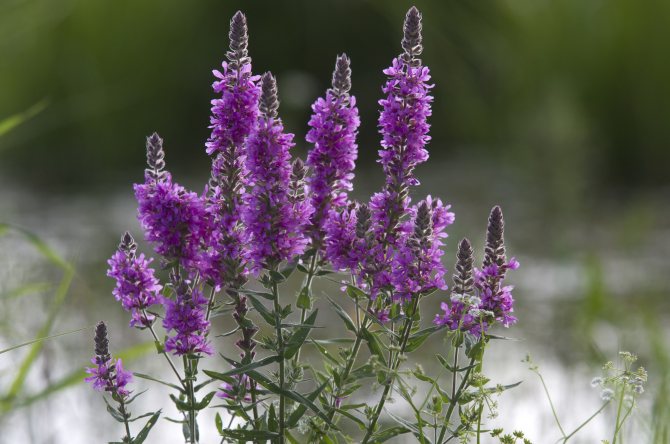

The plant does not need special conditions for active growth, since the willow loaf is a frost-resistant, perennial plant. It is able to take root on any soil, however, to form a lush and long-flowering bush, it is recommended to plant the plant in bright, damp places. A well-moistened soil enriched with nitrogen-containing fertilizers is suitable for good growth and abundant flowering. The bush grows comfortably and densely in summer in stagnant water at a depth of up to 30 cm.
When the plant fades, dry peduncles are cut off, the green part is either removed or left until spring.
Due to its good frost resistance, the loosestrider does not need additional shelter for the cold period of time; it is enough to wrap it up with snow. In a winter with little snow, avoiding the possibility of frostbite of the root system, it is better to cover the plant.
When choosing a top dressing, preference is given to nitrogen-containing fertilizers, while its excess in the soil leads to oppression of the plant.
Watering
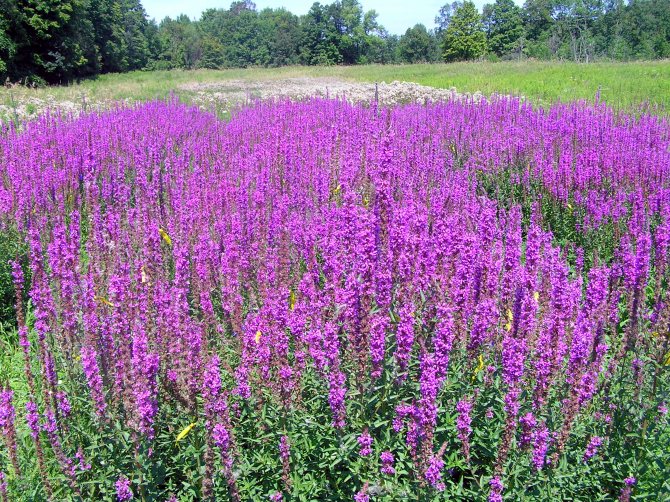

Prefers moist soil, therefore it is recommended to water the roots well 2 - 3 times a month and prevent the soil from drying out. Constant loosening and weed control have a beneficial effect on the growth and flowering of the bush.
How to plant a Derbennik correctly
Planting is carried out traditionally. Before that, it is recommended to prepare the soil, for which organic fertilizers are used. After the plant is planted in the soil, abundant watering should be done. If seedlings are planted, then the distance between each flower should be at least thirty-five centimeters. In the case of dividing an adult plant into parts, the distance should be of the order of half a meter.
A beautiful bright flower will retain its decorative appearance for many years. The plant does not require transplantation and rejuvenation.
Transplant and reproduction


There are three ways of breeding loosestrife:
- seeds;
- cuttings;
- vegetative division of the bush.
The cutting method is the easiest and most widely used one. To propagate the bush, use root cuttings cut at the beginning or middle of summer. After planting the cuttings in the ground, the soil moisture is monitored. During the growth period of cuttings of the root system, they need constant care: watering, loosening, feeding. In the fall, before frost, the cutting is planted in the place of the future flower bed.
With the vegetative method of reproduction, a lot of skill and patience will be required, since separating part of the rhizome is a very difficult task. In an adult bush, the roots are stiff, so an ax is needed to separate them. Experienced gardeners are advised to resort to the method of vegetative propagation of the plant only with young bushes.
The loosestrife seeds are harvested after the flowering season.
Growing a loosestrife from seeds
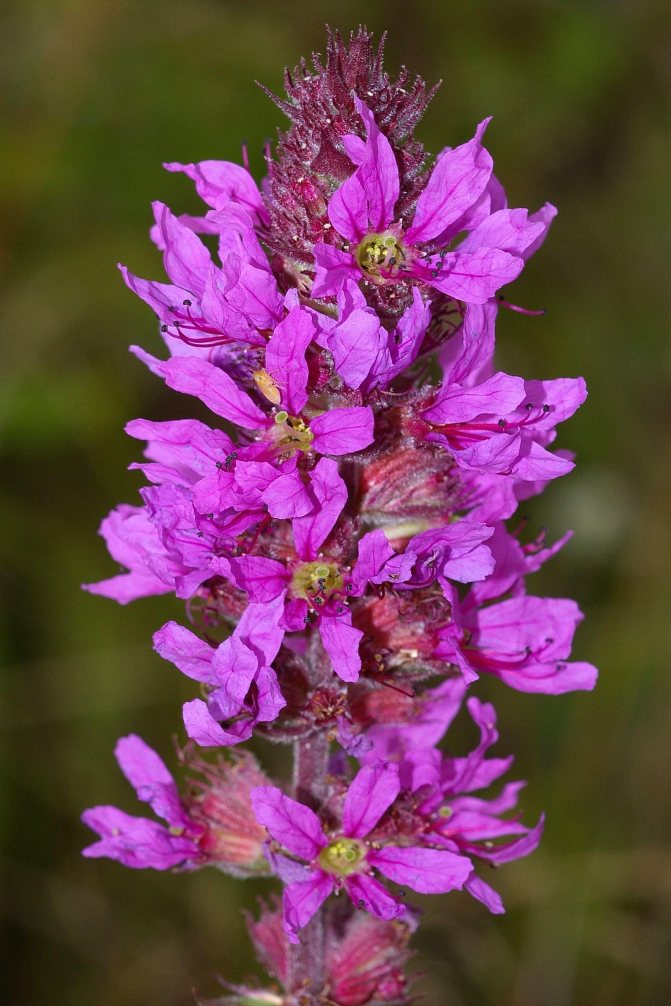

Cultivation of loosestrife from seeds is carried out in the middle of winter or early spring, by planting in the ground. Favorable temperature for sowing and germination of seeds is + 12 ... + 17 degrees. The first shoots will appear in a month. Creation of greenhouse conditions for young sprouts is necessary for good growth of healthy shoots. Landing in open ground is carried out in May. When the loosestrife is propagated by seeds, the first arrows with flowers can be seen in 2 - 3 years.
Sowing loosestrife seeds
It can be planted directly on the seedling bed in the ground in early spring after the snow melts, as well as in autumn, in October. With this growing
The loosestrife will not bloom for the second year after sowing. To get the loosestrife bloom in the first year, plant the seedlings in March.
Sowing loosestrife seeds
surface. Spray the soil with the sown seeds from a spray bottle and cover with polyethylene film or glass to create a greenhouse effect and even germination of loosestrife seedlings. The optimum temperature for seedlings is +15 +18 0 C. After the appearance of three or four true leaves, plant the loosestrife seedlings in separate cups. As soon as the threat of frost has passed, the seedlings can be planted in a permanent place, observing the optimal distance between the plants - 35-40 cm.
The use of loosestrife in traditional medicine
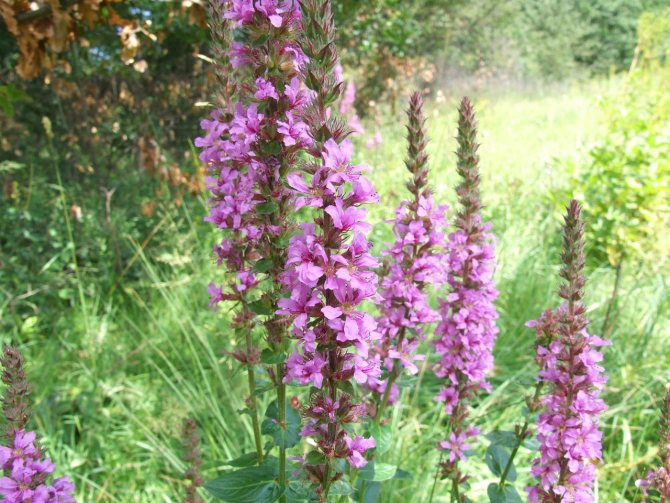

The willow loaf has long been known for its medicinal properties. It is actively used in the treatment of folk remedies. The wide range of uses of the medicinal plant makes it a truly unique and valuable natural resource.
The use of loosestrife is recommended for diseases of the digestive system, nervous disorders, and for skin lesions. The plant is most in demand as a hemostatic, restorative, wound healing, anti-inflammatory, sedative, antiseptic, diuretic. It has proven itself well in the treatment of respiratory diseases, headaches, dysentery, epileptic seizures, toxicosis, rheumatism and other diseases.
Drinks made from the leaves and flowers of the plant have tonic properties, as well as a pleasant aroma and slightly astringent taste.
Dosage forms
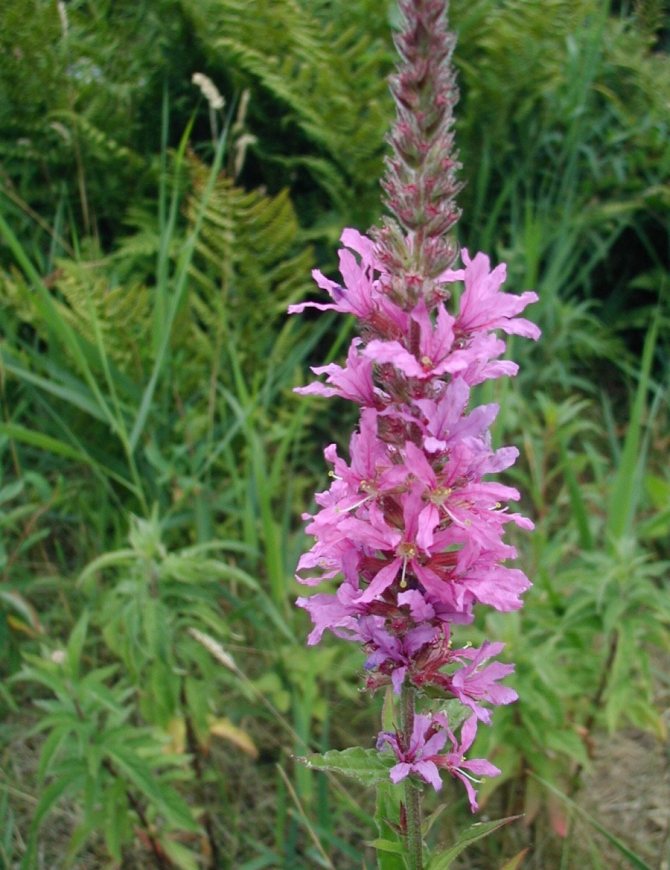

All parts of the plant are used as a remedy: roots, stems, flowers, leaves. The plant is rich in vitamins, flavonoids, glycosides, trace elements, essential oils, organic acids and other useful substances. In addition, the root system is rich in tannins (tannin).
The stem and leaves are cut before flowering, the flowers are in the active phase, and the roots are harvested after flowering.
After harvesting, the roots of the plant are washed and separated from the rest of the bush.All components must be completely dried in a well-ventilated area.
The use of loosestrife
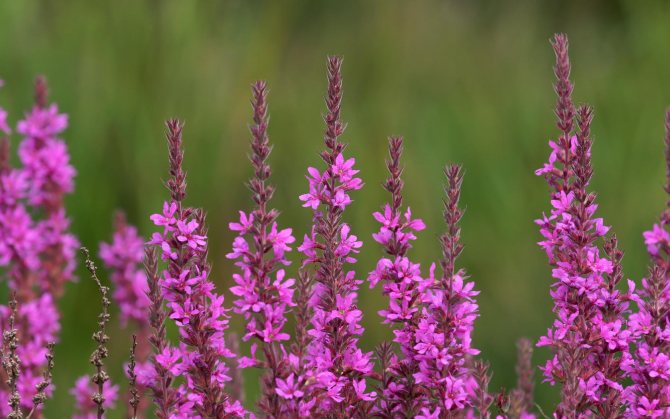

For the treatment of various diseases, in the absence of contraindications and the presence of a doctor's recommendation, medicinal medicinal infusions, teas and decoctions are used.
The broth is prepared in a water bath: a couple of tablespoons of dry crushed plant parts in 100 ml of water are simmered for 30 - 45 minutes. After that, the container with the broth is wrapped in a towel for another 20 minutes for better disclosure of all nutrients. Drink the broth warm, half a glass 3 times a day before meals. Used for diseases of the gastrointestinal tract, female reproductive organs, neuroses, hemorrhoids, prostatitis, as a diuretic.
On the basis of the roots, vodka tincture is made, which is used for headaches, colds, bruises, stomach diseases, toxicosis during pregnancy. Loose tea has proven to be an excellent remedy for headaches.
Freshly mashed grass is an excellent hemostatic agent; green mass is applied to a wound or bruise.
Contraindications for use


A drug based on various parts of the loosestrife is not recommended for:
- high chance of blood clots;
- increased blood clotting rate;
- hypertension;
- atherosclerosis;
- impaired bowel function (constipation).
Harvesting and storage of grass
Since the stems and roots have healing power in the loosestrife, tinctures and infusions are made from all these parts. The most successful time for harvesting is the period in which the weeping grass blooms, in the first half of summer.
Among the variety of flowers, some gardeners opt for the wonderful Lythrum plant. Among the people it is also called plakun-grass, upland reed, bobber. This interesting shrub with abundant pink or purple blooms will brighten any garden area.
Loosestrife is well known
in folk medicine due to its medicinal qualities. This herb is able to stop bleeding, have a diuretic effect, and is also used for fever, colic, colds, toxicosis during pregnancy. Simply put, the plant is noteworthy. How to nurture this herb in your garden?
Application in landscape design
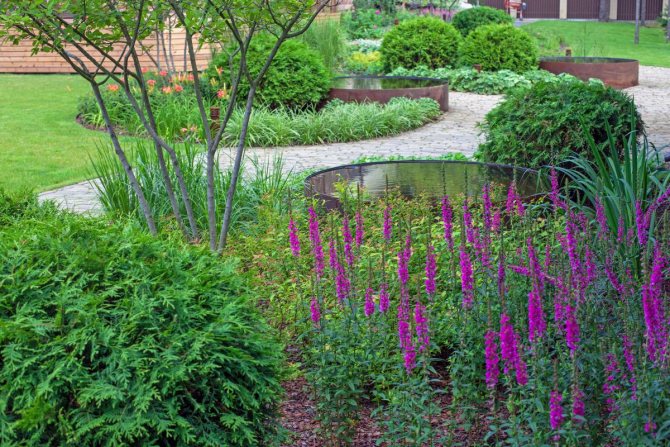

Bright saturated colors, unpretentious disposition and long flowering make the loosestrife an excellent companion in the design and creation of landscape design. Most often it is used in compositions with muted cold blue tones of such plants as "Blue Fortune" agastakhe, snow catchers, catnips, mordovniks, geraniums of "Brookside" and "Rosanne" varieties. Intense colors look great with mountaineers, Chinese astilba, Helianthus "Lemon Queen", steep. Excellent garden solutions are obtained when combined with various shrubs of barberry, mock orange, deren, bladder.


The use of loosestrife of different types, heights and colors in landscape design allows you to create excellent garden solutions. In combination with Japanese spirea, the garden will sparkle with bright shades from soft pink to rich crimson. Highlanders, daylilies, asters of the varieties “Prince”, “Lady in Black”, “Horizontalis” will well complement the flower garden with a loosestrife.
Many garden landscape designers advise diluting bright colors with softer, calm shades. A smooth transition from bright spots of “glowing candles” to calm pastel colors will give the flower garden a more serene, calm look. In this case, an excellent solution would be to use the phalaris “Picta” and “Luteopicta”, astilba of the Chinese “Purpurlanze”, and the beetle of the sharp-flowered “Karl Forster”.


For lovers of traditional medicine, a good option would be to organize a “medicinal flower garden”, where, in addition to the loosestrife, oregano, mint, valerian, tarragon, echinacea, magnificent elecampane, medicinal burnet, gravilata are planted.
They perfectly combine and attract many beautiful butterflies motherwort, lovage, horse sorrel, monarda. These plants not only decorate the garden, but also bring amazing aromas, attract beneficial insects such as bees and bumblebees.
Stories of the appearance of plakun-grass
Eurasia is considered to be the birthplace of the willow-grass. In the wild, its range covers all of Eurasia, the northern part of the African continent, North America and Australia.
Old Russian "derba", from which the Russian name of the plant comes, means a damp deposit covered with moss and korzhazhnik. Its other name - podberezhnik, indicates that the plant prefers humid habitats - river banks, the outskirts of swamps, damp ditches.
The beautiful reddish-purple inflorescences of the loosestrife are pleasing to the eye from June to September. For its unpretentiousness, beauty, long flowering, the plant has become widespread in household plots.
How to care for a plant
Placun grass requires the following care:
- regular watering,
- loosening the soil,
- feeding with mulch, peat or compost,
- pruning a bush.
Watering the plant is necessary during the driest periods., since a slight lack of moisture in the soil tolerates the loosestrife very well. You should not be afraid of waterlogging, as it is a moisture-loving culture. The soil is loosened in order to provide it with oxygen in the required amount. You can also feed the loosestrife with mineral nitrogen-containing fertilizers, but in limited quantities. Otherwise, the shoots will droop. The bush of the plant is capable of self-sowing, therefore, unwanted shoots should be cut off. When pruning, the bushes can be given any shape.
The stems are cut immediately after flowering. Some gardeners leave the entire bush completely until spring, since the plant is decorative and looks very attractive without flowers. In addition, the loosestrife does not require shelter for the winter. It is recommended to do this only in severe frosts.
It should not be forgotten that weeds must be removed... Although the plant has a dominant ability, it is better to destroy all weeds so that the appearance of the composition is not damaged.
Loose grass characteristic
Under natural conditions, it is distributed everywhere, including in Russia. In nature, loosestrife grass grows mainly in moist, fertile, well-sunlit areas. It can be found on the banks of rivers, near streams, lakes and other bodies of water.
The genus includes 30 species. Some of them are valued for their decorativeness, others are planted for their medicinal properties, but all, without exception, are recognized as excellent melliferous plants.
According to its characteristics, it is a perennial rhizome plant with a height of 1-1.5 m. Stems are thin, straight, densely leafy. Leaves are dark green, whole, oblong-linear, alternately arranged.
As follows from the botanical description of the loosestrife, its flowers are single, small, star-shaped, with a lilac-pink tint, formed in the leaf axils, collected in a spike-shaped inflorescence. The flower cup is tubular or bell-shaped. This plant blooms in summer, usually in July - August.
The fruit is a round, oblong capsule filled with seeds.
What to feed
To ensure stable flowering, the plant must be able to obtain the necessary nutrients from the soil. In early spring, it is recommended to feed with organic matter, it is best if it is mulching with compost or peat, which is carried out immediately after planting the plant in the ground. After that, every spring, the whole process should be repeated.
When the loosestrife begins to bloom, you can use mineral fertilizers, which stimulate the appearance of new flower stalks and make the color range brighter and more saturated.It is allowed to use any fertilizer for flowering plants, only if they do not contain a large amount of nitrogen. Placun grass does not tolerate excess nitrogen, which affects its appearance.


Planting seedlings
If a method of planting ready-made seedlings is chosen, then it is better to immediately take care of the place of their constant growth. Planting should be done as deep as possible to allow the plant to root better. It is also necessary to observe an interval of at least 40 cm. To obtain a healthy and developed bush, it is recommended to fertilize the soil. In particular, willow loosestrife feeds well on compost and loves peat diluted with fertile garden soil. This combination of supplements will ensure the full development of plakun grass and ensure an adequate supply of nutrients during periods of drought. In addition, it is worth mulching the soil with loose compost, and in the summertime feed the seedlings with mineral fertilizers.
Useful qualities
From the point of view of medical needs, loosestrife is a waste-free plant. Experienced summer residents use roots, leaves, flowers and seeds for these purposes. The greatest healing effect is given by flowers, which should be collected immediately after blooming. Then they are dried, crushed and used for tinctures and decoctions. There are many diseases that the willow loaf is successfully combating. The medicinal properties of the plant are due to the presence of polyphenol and tannin. These substances are used for venous insufficiency, headaches, respiratory tract diseases, as well as for the elimination of harmful toxins and salts. Tinctures prepared from the aerial part of the loosestrife are preferably used for the prevention and treatment of gastric diseases. In addition, extracts can be useful as a sedative in neuroses.
Site selection
In many areas, there are reservoirs that will look exquisite if the willow loaf becomes their decoration. If the owner of a piece of land chooses it, he should know about the main features of planting a loosestrife. It is best to give preference well-lit or slightly shaded areas, as this culture loves light, nutritious and well-moisturized soil.
To provide the loosestrife with all nutrients, it is necessary to add peat to the soil on which the loosestrife grows. The proportion of this additive will be 10 buckets of peat to 1 square meter of land. The best for this type of plant will be a reservoir, near which it will be planted. But if this is not possible, and a pond, pool or other body of water is not provided in the garden, you need to purchase new hybrid varieties of loosestrife, which do not need a huge amount of moisture.
Preparing a loosestrife for winter
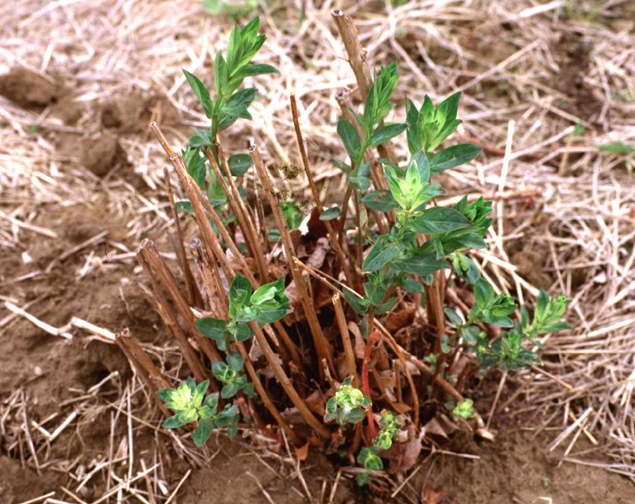

How the loaf of weepers winters grass photo
The loosestrife is a frost-hardy plant. For wintering in the middle lane, plakun-grass bushes do not need to be covered. Hilling a merlin with dry leaves or sawdust is not a necessary measure to preserve the plant in the winter. They withstand average frosts perfectly, even without snow.
Is the loosestrife cut for the winter?
Yes, old shoots need to be cut off, because in the spring they will interfere: the plant will wake up early and it will be possible to damage the young shoots during spring pruning. Pruning a loosestrife for the winter is not difficult: all the shoots are cut off, leaving 8-10 centimeter sticks above the ground.
Nutritional value and chemical composition
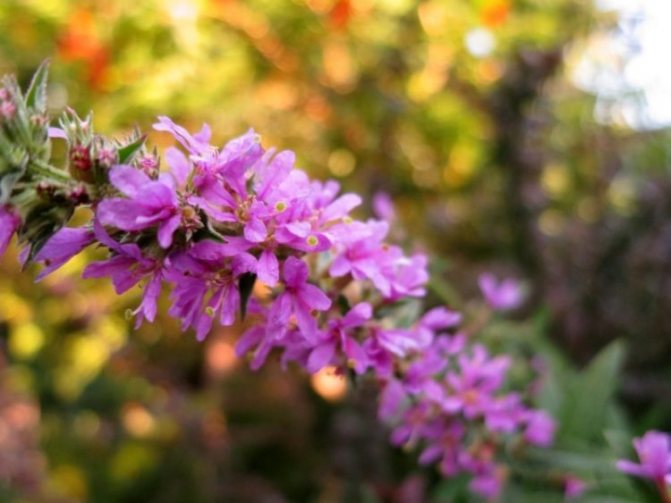

Almost all varieties of loosestrife contain many substances useful for the human body. So, plakun-grass has the following chemical composition:
- essential oils that increase the beneficial properties of other components;
- flavonoids;
- tannins;
- polyphenols;
- phenolcarboxylic acids, which have a diuretic effect;
- vitamin C;
- resin;
- glycosides;
- organic acids;
- carotene;
- pectin;
- glucose;
- saponins.
Harm and contraindications
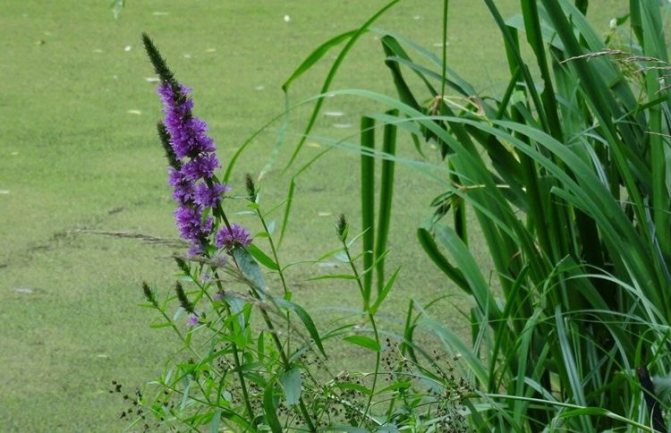

Using flowers or loosestrife grass without a medical prescription can harm your own health. Elderly people, pregnant women and children should be especially careful when using plakun-grass. The loosestrife has some contraindications for use:
- constipation;
- increased blood clotting;
- pressure surges;
- tendency to form blood clots;
- plant allergy;
- atony or acute intestinal inflammation.
How to trim a flower
Among the prerequisites for caring for Derbennik is its pruning, which is carried out only once a year. It is recommended to remove all ground parts that have survived from the previous year. You can cut off shoots before or after the winter period.
You can form the general shape of the bush, depending on your preference, the shape of a number of growing flowers and landscape design. It is recommended to cut the flower stalks before the seeds begin to ripen, as there can be a lot of self-seeding. Moreover, the plant takes root very well from seeds and can quickly spread over the site.


Rules for pruning willow leaves
Plant pruning should be done continuously. Often for all plants, pruning is standard, it is one and is called sanitary. In this case, the so-called ground parts are removed, that is, those that remained from last year. The loosestrife should be pruned in the fall.
Trimming can also be formative and is done based on what composition you are using and what shape you are trying to create. This pruning process is most advisable in the summer. Before the seeds begin to ripen, it is important to cut off those flower stalks that have already finished flowering.
Willow loosestrife can perfectly self-sow, due to which it belongs to aggressive plants. Seeds from it can perfectly take root and germinate quickly. Therefore, if you do not want to eliminate this plant throughout your garden, the cut of the inflorescences must be carried out in time, until the seeds are scattered throughout the territory.
Popular: Growing and caring for a universal platycodon bell


Pests and diseases
Pests and diseases are capable of infecting any plant and the loosestrife is no exception in this case. If this culture grows on the territory of your garden, then it is affected by aphids. It gets on a densely overgrown loosestrife from neighboring plants. For this reason, in order to prevent this insect from infesting the loosestrife, you should often monitor your bush. If the aphid has already settled on the crop, then insecticides must be applied immediately.
Where is the best place to plant?
The initial conditions mean a lot for the growth of the looser Therefore, it is better to plant in a partial shade or sunny place. Although willow loosestrife is a grass that does not require special qualities of the soil composition, it is advisable to choose a damp and ventilated soil. The presence of nutrients in it will also not be superfluous. Some gardeners also practice planting in highly moist soils. Moreover, if there is a pond or reservoir on the site, then in the summer you can move the shrub to a depth of no more than 30 cm.
Types of loosestrife willow
Many summer residents and gardeners, when arranging their plots, are faced with a choice between shrubs and herbaceous plants. The former are often not suitable because of the large area required for full-fledged growth, and the grass does not always satisfy the aesthetic needs of the owner. In such a situation, it is worth paying attention to the willow loosestrife, which is also called plakun-grass. This amazingly beautiful plant has a small stem size (when compared with shrubs), but at the same time it clearly stands out against the background of an inconspicuous herbaceous cover.In addition, the plakun will become a good helper in the home medicine cabinet - the healing properties often become the main reason why it is grown.
Disease and pest control
The stem of the peduncle and the leaves are the favorite places for the settlement, feeding and breeding of aphids. To combat and prevent infection, willow loaf is sprayed with infusions of citrus peels, garlic, tobacco, tomato leaves, onion husks.
Placun grass belongs to herbaceous perennials, completely resistant to fungal infections, diseases and pests, and does not need special preventive or protective measures.
The loosestrife is not afraid of attacks from pests and all sorts of diseases. But in the vicinity of roses, it is often attacked by aphids, which are located on the inside of the leaves and stems, preventing the plant from fully developing. In addition, the insect actively spreads to other flowers in the flower bed, which is subsequently accompanied by massive fungal and bacterial diseases. Insecticides will help to destroy aphids. A good result is given by drugs "Aktara", "Bi-58 New".
Choosing a place for planting a loosestrife
Despite its light-loving nature, the plant is very plastic in relation to growing conditions and can tolerate partial shade if it is open to the sun for at least several hours a day. His favorite soil is peat, but it will be able to put up with other soils, in addition to overly alkaline. Also, do not plant this flower on either too dense or too loose soil. Its nutritional value is not so important, it can grow and bloom successfully even on poor soil. If it is too poor and clay-dense, it is recommended to add high-moor peat for planting at the rate of 10 buckets for every 1 sq. M. They are not an obstacle to planting a loosestrife and even damp places are desirable, moreover, it can grow not only near the water itself, but even in shallow water. But the plant does not like constantly blowing winds and, as a rule, lodges from the wind under the weight of large inflorescences, especially in rainy times.
In China, this perennial can often be found in rice fields, half-flooded with water.


